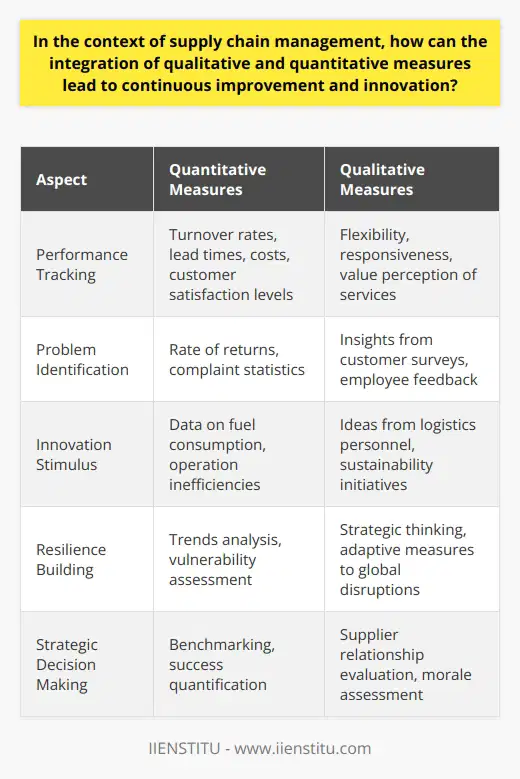
This article discusses the importance of measuring the performance of a supply chain for businesses. It explains the use of quantitative metrics, such as inventory turnover, customer order fulfillment rate, on-time delivery rate, and cost per unit, and qualitative metrics, such as customer satisfaction, supplier relationships, and employee morale. The article also highlights the benefits of measuring supply chain processes, such as cost reduction, improved customer satisfaction, and increased efficiency.
Introduction
Quantitative Metrics
Qualitative Metrics
Benefits of Measuring Supply Chain Processes
Conclusion
Introduction
Measuring the performance of a supply chain is essential for any business that wants to remain competitive and successful. A supply chain can be viewed from various perspectives, such as flows, functions, communities, or systems.
However, regardless of the perspective, it is important to be able to measure what is happening in the supply chain. In order to do this, businesses need to utilize both quantitative metrics and qualitative metrics.
Quantitative Metrics
Quantitative metrics are numerical measurements of the performance of a supply chain. These metrics are important for businesses to track because they provide them with a clear and concise view of the supply chain’s performance.
Common quantitative metrics used to measure the performance of a supply chain include inventory turnover, customer order fulfillment rate, on-time delivery rate, and cost per unit.
Qualitative Metrics
Qualitative metrics are subjective measurements of the performance of a supply chain. These metrics are important for businesses to track because they provide them with an in-depth view of the supply chain’s performance.
Common qualitative metrics used to measure the performance of a supply chain include customer satisfaction, supplier relationships, and employee morale.
Benefits of Measuring Supply Chain Processes
Measuring the performance of a supply chain is important for businesses because it provides them with the information they need to identify areas of improvement and make necessary changes.
By tracking quantitative and qualitative metrics, businesses can gain valuable insights into their supply chain processes and make more informed decisions. Additionally, measuring supply chain processes can help businesses reduce costs, improve customer satisfaction, and increase efficiency.
Conclusion
Measuring the performance of a supply chain is essential for businesses that want to remain competitive and successful. Quantitative metrics and qualitative metrics are both important for businesses to track in order to gain insights into their supply chain processes and make informed decisions. Measuring supply chain processes can help businesses reduce costs, improve customer satisfaction, and increase efficiency.
Accurately measuring the quality and quantity of your supply chain processes is essential for achieving success.
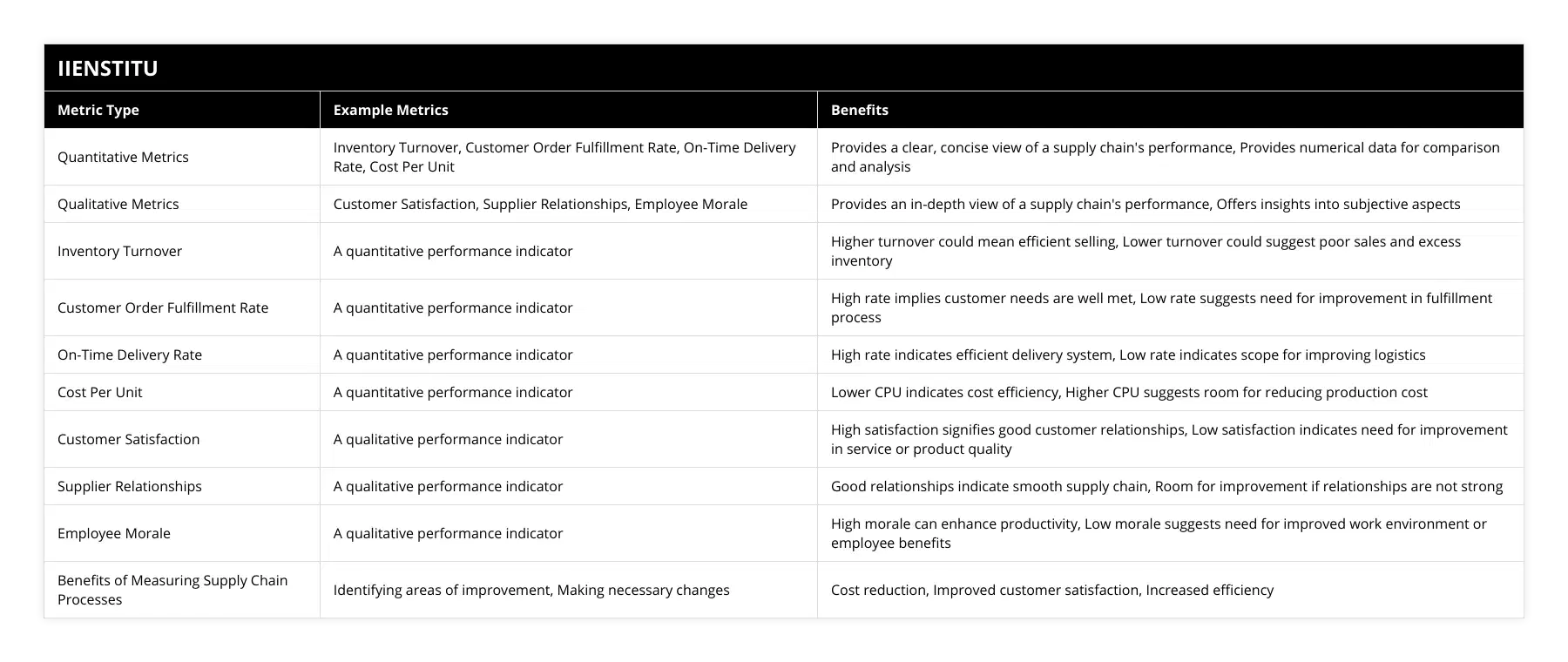
The article underscores the significance of gauging the efficacy of supply chain processes for the longevity and competitiveness of any business. It summons the attention to both quantitative and qualitative metrics that are instrumental in procuring exhaustive insights into the entire supply chain performance, affecting strategic decision-making. These metrics can be utilized to identify areas of improvement, mitigate costs, enhance customer satisfaction, and boost efficiency. Ultimately, a combination of effective measurement tools and a supply chain certification can act as a fulcrum to balance the quality and quantity aspects of the supply chain, thereby fostering success for a business.
Frequently Asked Questions
What are the most important quantitative metrics for measuring supply chain processes?
The most important quantitative metrics for measuring supply chain processes include inventory turnover, customer order fulfillment rate, on-time delivery rate, and cost per unit. By tracking these metrics, businesses can gain valuable insights into their supply chain processes, which can lead to cost reduction, improved customer satisfaction, and increased efficiency.
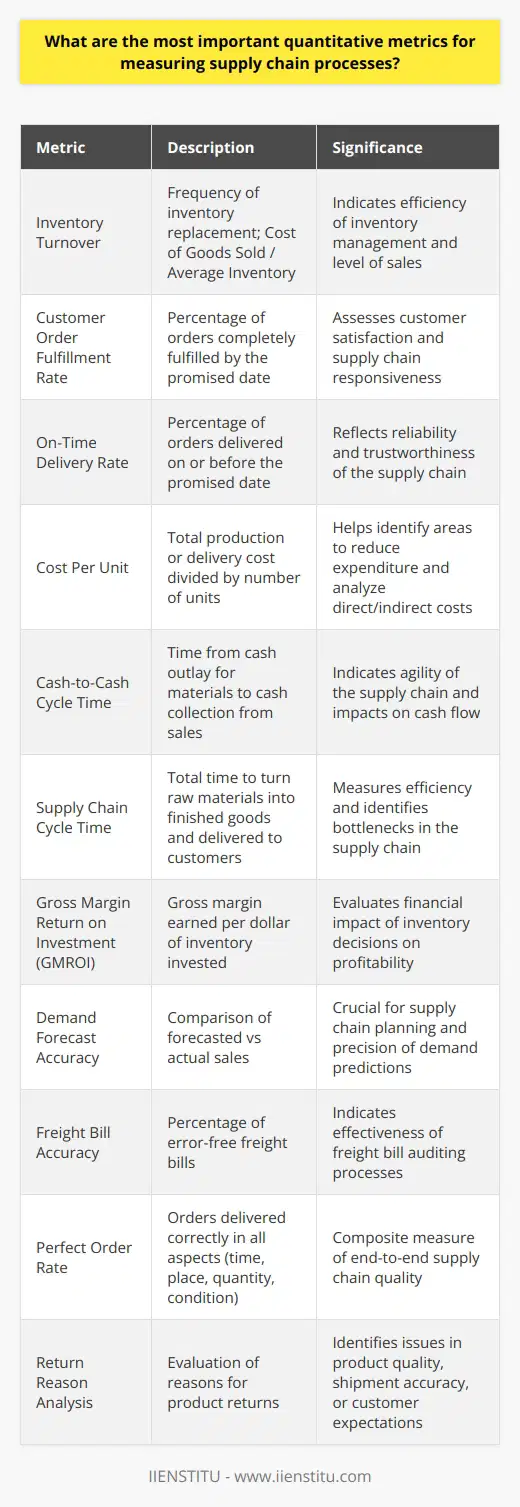
How can qualitative metrics be used to measure supply chain processes?
Qualitative metrics can be used to measure supply chain processes by measuring customer satisfaction, supplier relationships, and employee morale. These metrics provide insight into customer service and the overall functioning of the supply chain, enabling businesses to identify areas of improvement and develop strategies to ensure a smoother and more efficient supply chain. Qualitative metrics are also useful for assessing the impact of customer feedback, employee performance, and supplier satisfaction on the overall supply chain process. By tracking these metrics, businesses can gain valuable insights into their supply chain processes and make more informed decisions.

What are the benefits of measuring supply chain processes?
The benefits of measuring supply chain processes include cost reduction, improved customer satisfaction, and increased efficiency. Companies that measure their supply chain performance can identify areas of improvement, leading to reduced costs and improved customer satisfaction. Additionally, companies can improve their efficiency and identify areas of waste, leading to increased profits. By tracking supply chain performance, companies can make more informed decisions and create a more efficient and cost-effective supply chain.
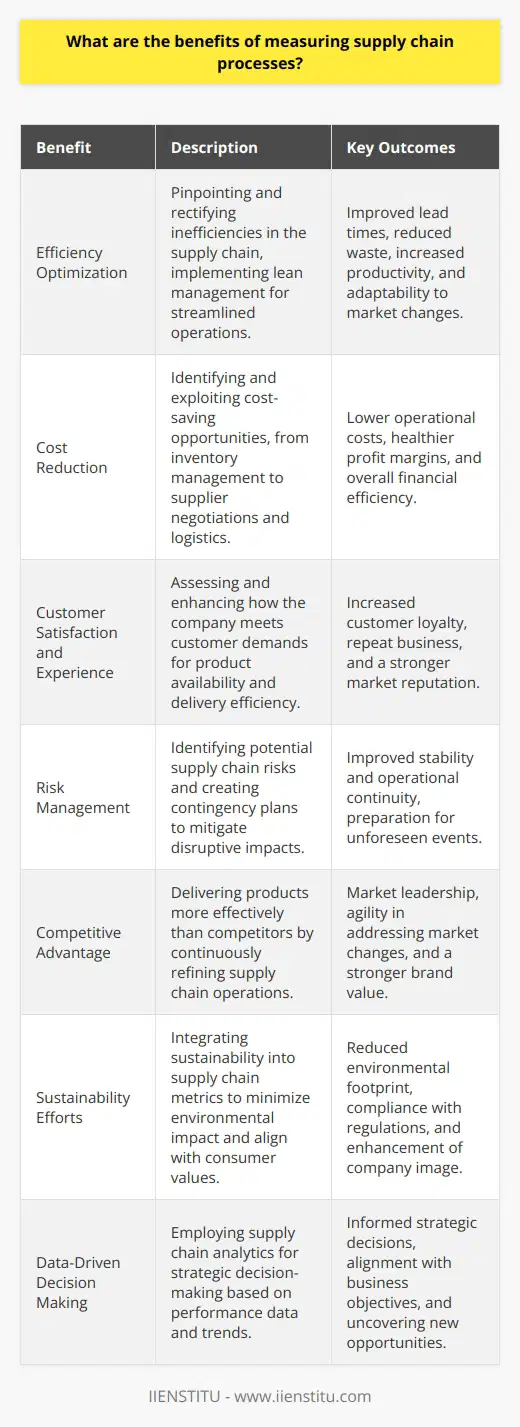
What are the key differences between qualitative and quantitative performance metrics in supply chain management?
Key Differences
One of the primary distinctions between qualitative and quantitative performance metrics in supply chain management lies in the nature of data used for measuring performance. Quantitative metrics utilize numerical data and statistical analysis methods, while qualitative metrics are based on descriptive data and subjective interpretations.
Quantitative Performance Metrics
These metrics involve the use of numerical values, allowing organizations to objectively track progress and make data-driven decisions. Some common quantitative performance metrics in supply chain management include efficiency ratios (e.g., inventory turnover, order fill rate), time-based metrics (e.g., order cycle time, delivery reliability), and cost-based metrics (e.g., total logistics costs, transportation costs). By analyzing trends and patterns in these measurable data points, businesses can identify areas of improvement and implement targeted strategies to optimize their supply chain operations.
Qualitative Performance Metrics
In contrast to quantitative metrics, qualitative performance metrics involve the evaluation of non-numerical factors, such as stakeholders' perception and experience, the quality of supplier relationships, and the effectiveness of communication within the supply chain. These metrics often rely on methods like surveys, interviews, and observation to gather insights that are not easily quantifiable. Despite their subjective nature, qualitative metrics can provide valuable context to quantitative data, offering a holistic understanding of the supply chain's overall performance.
The Role of Both Metrics in Supply Chain Management
The integration of both qualitative and quantitative performance metrics in supply chain management is essential to ensure a comprehensive assessment of the supply chain's effectiveness. While quantitative data offers the advantage of objective measurement, it may not always capture the nuances of complex processes and relationships within the supply chain ecosystem. Qualitative data, on the other hand, fills this gap by providing insight into stakeholders' perspectives and experiences.
In conclusion, understanding the key differences between qualitative and quantitative performance metrics in supply chain management is crucial for achieving optimal performance. By adopting a balanced approach that incorporates both types of metrics, organizations can gain a more accurate and comprehensive view of their supply chain operations, enabling them to make informed strategic decisions and drive continuous improvement.
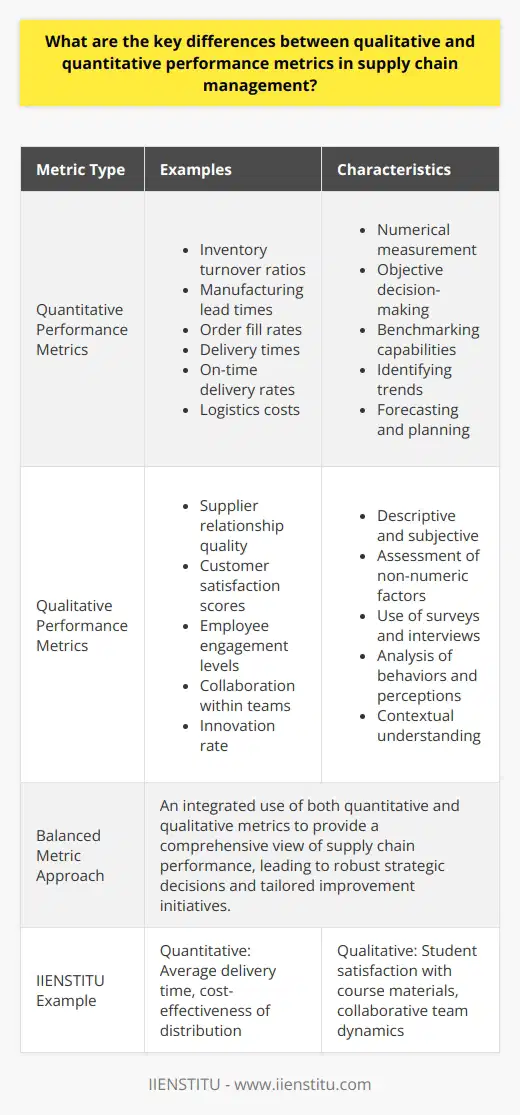
How can qualitative measures complement quantitative metrics to provide a comprehensive assessment of supply chain performance?
Understanding Qualitative and Quantitative Metrics
Qualitative measures offer valuable insights to supplement quantitative metrics in assessing supply chain performance. Quantitative metrics, such as key performance indicators (KPIs), provide objective data on efficiency, costs, and reliability. However, it may not capture the entire performance landscape. This is where qualitative measures come into play.
Role of Qualitative Measures
Qualitative measures address aspects that quantitative metrics might miss, such as customer satisfaction, employee engagement, and supplier relationships. They offer a deeper understanding of the factors influencing supply chain performance, leading to more informed decision-making. By combining both measures, organizations can gain a more comprehensive assessment of their supply chain's overall health.
Customer Satisfaction
Evaluating customer satisfaction through qualitative methods, such as surveys, interviews, and feedback can reveal insights into customer preferences, unmet needs, and potential areas for improvement. These insights can inform supply chain strategies, ensuring customer expectations are met and maintaining a competitive edge.
Employee Engagement
A supply chain is only as strong as the people who operate it. Assessing employee engagement through qualitative methods, such as focus groups and interviews, can reveal insights into workforce motivation, challenges, and skill gaps. By addressing these concerns, companies can improve employee satisfaction, reduce turnover, and enhance overall supply chain performance.
Supplier Relationship Management
Qualitative assessments of supplier relationships can reveal potential risks, opportunities, and areas for improvement. Evaluating these relationships through methods such as periodic performance reviews, site visits, and stakeholder feedback can help maintain strong connections, mitigate risks, and improve collaboration across the supply chain.
Integrating Measures for a Holistic View
A balanced approach between qualitative and quantitative metrics allows supply chain managers to derive insights from a variety of sources, leading to more informed decisions and better overall performance. By incorporating qualitative measures alongside quantitative metrics, organizations can obtain a comprehensive understanding of their supply chain's strengths and weaknesses, paving the way for continuous improvement and long-term success.
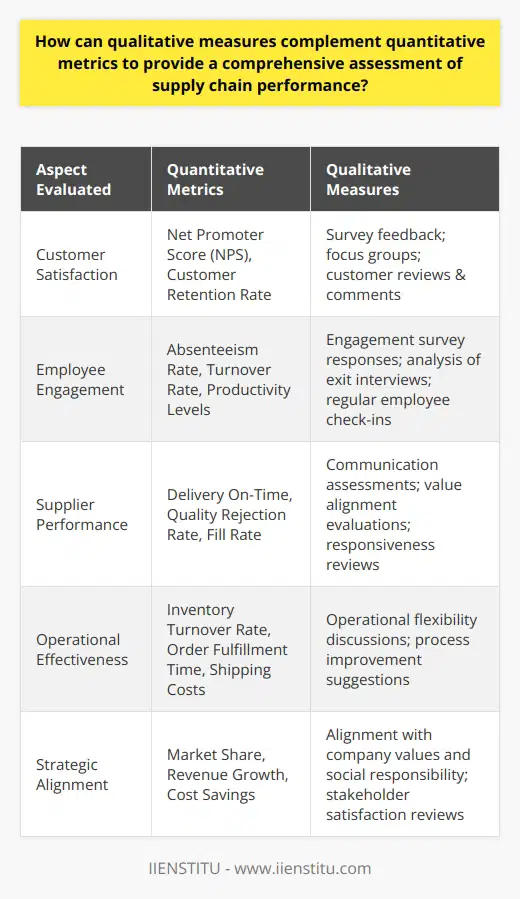
What factors should be considered when selecting appropriate metrics for evaluating supply chain processes?
Key Factors for Consideration
When selecting appropriate metrics for evaluating supply chain processes, it is essential to consider several key factors. These factors ensure the chosen metrics align with organizational goals and provide valuable insights for decision-making.
Alignment with Organizational Goals
First, metrics should align with the organization's overall goals and objectives. This ensures that evaluations focus on aspects that contribute to the organization's success and that any improvements identified will be relevant and valuable.
Comprehensiveness of Metrics
A comprehensive set of metrics should be selected to provide a complete picture of the supply chain processes. A balance between financial, operational, and environmental metrics should be considered to cover various aspects of the supply chain.
Benchmarking and Comparability
Selecting industry-standard metrics allows for benchmarking and comparability with other organizations. This enables an organization to gauge its performance against competitors and identify areas where it is excelling or lagging.
Actionability and Relevance
Metrics must be actionable and relevant, allowing organizations to make informed decisions for improvement. Ideally, these metrics should identify specific issues that can be addressed promptly to improve overall supply chain performance.
Ease of Measurement and Accurate Data
The metrics chosen should be easy to measure and collect data for, ensuring that accurate and timely information is available for evaluation. This also helps in reducing the effort and resources required to track the metrics.
Adaptability and Flexibility
Lastly, the selected metrics should be adaptable and flexible to accommodate changes in the organization or supply chain processes. This allows the organization to continuously evaluate its performance and make adjustments when necessary.
In conclusion, selecting appropriate metrics for evaluating supply chain processes requires careful consideration of various factors. By ensuring that the chosen metrics align with organizational goals, are comprehensive, allow for benchmarking and comparability, are actionable, utilize accurate data, and are adaptable, organizations can continuously improve and optimize their supply chain processes to achieve success.

What are the essential components of an effective supply chain performance measurement system?
Key Metrics and Indicators
An effective supply chain performance measurement system should comprise key metrics and indicators that monitor various aspects of the supply chain. These metrics may include inventory turnover ratio, order fill rate, order cycle time, and stock-out incidents. By analyzing these indicators, businesses can identify areas of improvement and optimize their supply chain performance.
Integration and Collaboration
Integration and collaboration among supply chain partners are essential for a comprehensive performance measurement system. By sharing information and resources, businesses can enhance their supply chain visibility and adapt to changes in the market more efficiently. This collaboration plays a vital role in maintaining a high level of service and product quality across the supply chain.
Balanced Scorecard Approach
An effective supply chain performance measurement system should adopt a balanced scorecard approach. This entails assessing financial, operational, and customer-focused metrics to provide a holistic overview of performance. By evaluating these different dimensions, businesses can develop strategies to address potential weak points and capitalize on opportunities.
Flexibility and Adaptability
An ideal supply chain performance measurement system should be flexible and adaptable to the ever-changing nature of the supply chain. It should consider the uncertainties and risks that may arise due to fluctuations in demand, supply, or external factors. Businesses should be able to modify their performance measurement process according to their current needs and market conditions.
Benchmarking and Continuous Improvement
Comparing performance metrics with industry benchmarks enables businesses to identify their position among their competitors. By engaging in benchmarking, organizations can learn best practices from industry leaders and implement strategies that promote continuous improvement. This mindset not only helps in enhancing supply chain performance but also promotes overall business growth.
In conclusion, an effective supply chain performance measurement system should have well-defined metrics and indicators, promote integration and collaboration, utilize a balanced scorecard approach, be flexible and adaptable, and emphasize benchmarking and continuous improvement. By incorporating these essential components, businesses can improve their supply chain operations and ultimately achieve better profitability and customer satisfaction.

How do qualitative and quantitative metrics in supply chain management affect overall business performance?
Impact on Business Performance
Both qualitative and quantitative metrics significantly impact overall business performance in supply chain management. Quantitative metrics, which involve numerical measurements, help businesses monitor and evaluate supply chain performance by providing objective data. These metrics include key performance indicators (KPIs) such as inventory turnover, order-fulfillment lead times, and total cost of ownership.
Cost Savings and Efficiency
When properly monitored and utilized, quantitative metrics offer valuable insights into potential cost savings and efficiency improvements across the supply chain. By streamlining processes and optimizing resources, businesses can improve overall performance, benefiting both profitability and customer satisfaction.
Qualitative Metrics in Decision Making
In contrast to quantitative measurements, qualitative metrics focus on interpreting the external factors and subjective experiences that impact the supply chain. These may include customer feedback, supplier relationships, and employee satisfaction. Qualitative metrics are essential in making informed decisions regarding supply chain strategies, as they provide context and deeper understanding of the factors influencing performance.
Balancing Both Metric Types
It is crucial for businesses to balance both qualitative and quantitative metrics when assessing supply chain performance. Relying solely on quantitative metrics may lead to a disregard for the more subjective factors that impact the supply chain, whereas solely focusing on qualitative metrics may lead to a lack of tangible data to support decision making. A successful supply chain management strategy requires the integration of both metric types, allowing for a comprehensive and accurate assessment of overall business performance.
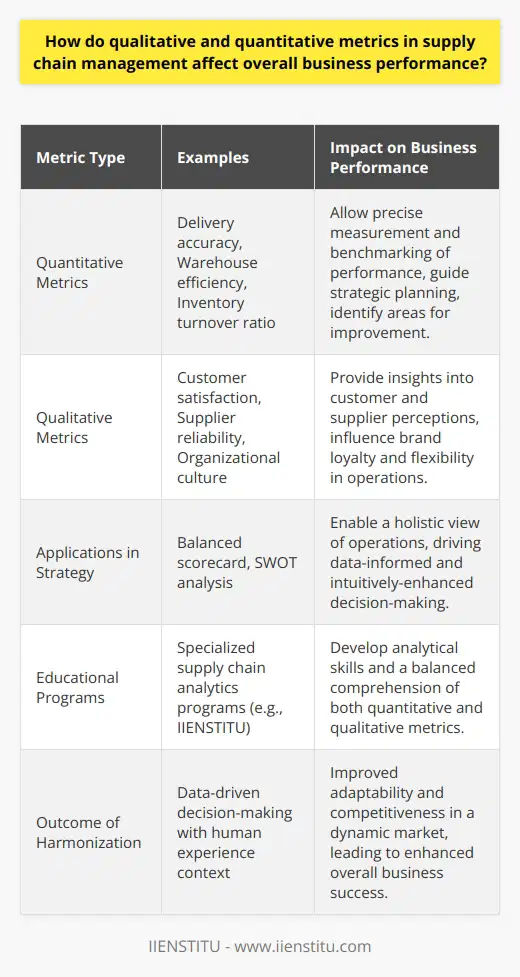
What are the challenges and limitations of using quantitative and qualitative performance metrics in supply chain management?
Challenges in Quantitative Performance Metrics
A key challenge in using quantitative metrics in supply chain management lies in accurately capturing the complexity of the supply chain. It is difficult to represent interrelated variables, such as lead times and stock levels, in a single metric. Furthermore, selecting the right indicators to measure performance can be cumbersome due to the sheer number of variables and the need to prioritize those directly relevant to achieving strategic objectives. Additionally, data collection and harmonization across multiple parties in the supply chain pose challenges, particularly when data inconsistencies and gaps occur.
Limitations in Qualitative Performance Metrics
With qualitative metrics, biases can emerge from the subjective nature of measuring human perceptions and opinions on various aspects of supply chain performance. The lack of a standardized approach to qualitative measurement may also result in incomparable or inconsistent outcomes. Furthermore, qualitative metrics are prone to varying interpretations, making them less suited for benchmarking or comparing supply chain performance across disparate organizations. In addition, the time-consuming and labor-intensive process involved in conducting surveys, interviews, or focus groups can limit the extent to which qualitative metrics can be used to make quick and informed decisions.
Integration of Both Metrics Types
Integrating quantitative and qualitative performance metrics in supply chain management can offer a more comprehensive understanding of the overall performance. However, this integration presents its own set of challenges, including the need to select and combine metrics that truly represent the supply chain's performance. The lack of uniformity in measurement approaches and data types can impede the process of integrating both quantitative and qualitative metrics, demanding extra effort in data analysis and the development of a unified performance framework.
Conclusively, while quantitative and qualitative performance metrics each have their own strengths and weaknesses in their ability to assess supply chain performance, a balanced approach that effectively integrates both types of metrics can provide a more holistic understanding of supply chain management performance. It is crucial for organizations to continuously evaluate and refine their metrics selection process and integration techniques to overcome these challenges and limitations while optimizing their supply chain performance.

What are the critical aspects to consider when implementing qualitative and quantitative measures in supply chain management?
Critical Aspects of Qualitative and Quantitative Measures
Understanding Supply Chain Objectives
When implementing both qualitative and quantitative measures in supply chain management, it is essential to first understand the objectives of the supply chain. Clear goals will provide a comprehensive framework for employing suitable measures effectively, which in turn will help in achieving desired outcomes, such as reducing costs or improving customer satisfaction.
Balancing Flexibility and Rigidity
Another critical aspect is to strike a balance between flexibility and rigidity in the supply chain management approach. While having standardized quantitative measures helps maintain consistency and ease comparability, supply chain managers should be open to adapting these measures when faced with unforeseen circumstances or changes in the business environment. On the other hand, flexible qualitative measures should be leveraged to gain contextual insights, allowing the supply chain to respond appropriately to unique situations.
Integration of Data Sources
Integrating both qualitative and quantitative data sources is indispensable for obtaining a holistic understanding of supply chain performance. Quantitative data, such as key performance indicators (KPIs), provides managers with concrete benchmarks, while qualitative data offers insights into the drivers behind performance fluctuations. Integrating these measures enables supply chain managers to identify areas for improvement and support decision-making processes with robust evidence.
Applicability and Relevance of Measures
The selection of qualitative and quantitative measures should be based on their applicability and relevance to the specific supply chain context. Supply chain managers need to consider factors such as complexity, geographic scope, and business priorities to determine which measures will be most effective in assessing supply chain performance. It is critical to align these measures with the supply chain objectives and strategies to ensure their effective contribution to business success.
Continuous Review and Improvement
Finally, continuous review and improvement of selected qualitative and quantitative measures are crucial for maintaining an efficient and effective supply chain. Supply chain management should regularly assess performance metrics and feedback mechanisms, refining them when necessary. By adopting a dynamic approach towards these measures, supply chain managers can ensure that their strategies remain relevant, and their supply chain continues to deliver optimal results.
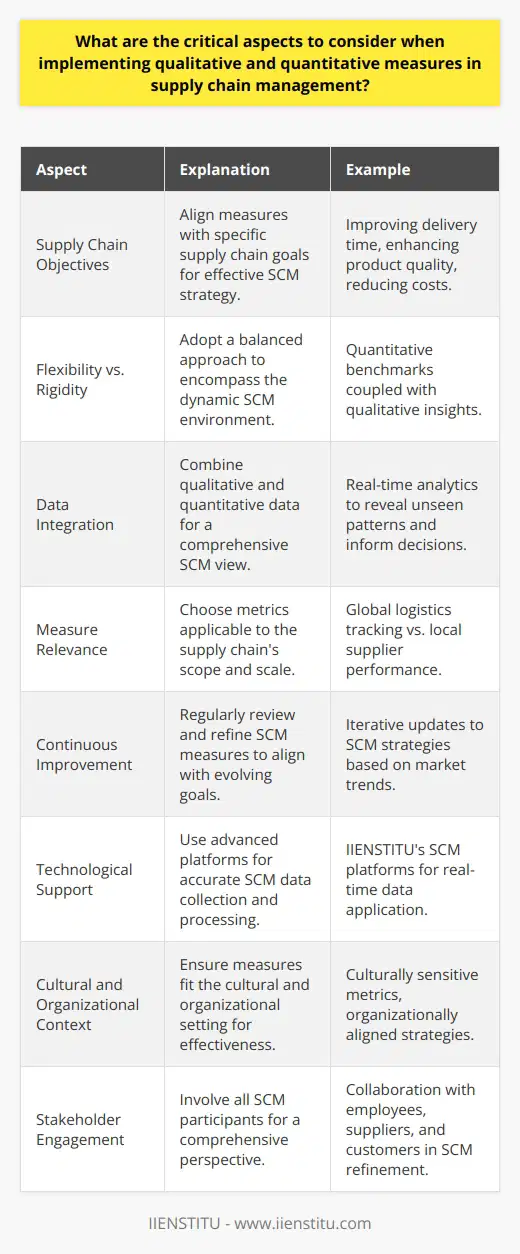
In what ways can quantitative metrics in supply chain management be augmented by qualitative insights for better decision-making?
Integrating Qualitative Insights
In supply chain management, quantitative metrics offer crucial numerical data for assessing performance and making informed decisions. However, these metrics can be further enhanced by incorporating qualitative insights, which provide a more comprehensive understanding of the supply chain's intricacies. Qualitative insights can be particularly beneficial when used alongside quantitative data in several key areas of supply chain management.
Stakeholder Perspectives
Firstly, qualitative insights enable supply chain managers to consider stakeholder perspectives, such as their values, expectations, and concerns. Incorporating stakeholder viewpoints is vital in aligning the supply chain strategy with customer preferences and meeting regulatory requirements. For instance, conducting interviews or focus groups with customers can reveal valuable information on how they perceive product quality, supplier responsiveness, or delivery timeliness.
Risk Identification and Mitigation
Secondly, qualitative research methods, such as expert judgment, case studies, and scenario planning, help identify and mitigate risks in the supply chain. Quantitative metrics may not fully capture the potential impact of unanticipated disruptions, whereas qualitative insights can reveal the nuances of vulnerability, enabling more effective risk management strategies.
Complex Trade-off Analysis
Thirdly, qualitative insights facilitate a more robust analysis of trade-offs that arise when implementing supply chain management decisions. Quantitative metrics rely on well-defined criteria, making it challenging to compare diverse aspects of supply chain performance. Qualitative insights, on the other hand, provide a more holistic understanding of the trade-offs involved allowing managers to make more effective decisions.
Incorporating Organizational Culture
Finally, qualitative insights can contribute to a greater understanding of the role that organizational culture plays in supply chain management. Through assessments like organisational ethnography and employee surveys, qualitative research can unveil the beliefs, attitudes, and practices that might impact supply chain performance. This information can help managers identify and address cultural factors that may hinder effective decision-making.
Conclusion
In conclusion, integrating qualitative insights with quantitative metrics in supply chain management offers a more comprehensive and nuanced understanding of the factors affecting performance. Qualitative research allows managers to account for stakeholder perspectives, risk identification and mitigation, trade-off analysis and organisational culture, facilitating better-informed decision-making. Thus, supply chain managers should seek to combine both quantitative and qualitative means in evaluating and optimizing their supply chains.

How can a balanced approach to qualitative and quantitative performance measurement contribute to overall supply chain sustainability and resilience?
Balanced Approach to Performance Measurement
A balanced approach to qualitative and quantitative performance measurement can significantly contribute to the overall supply chain sustainability and resilience. This approach comprises employing a mix of both qualitative and quantitative indicators to evaluate various aspects of the supply chain. By combining both methodologies, businesses can obtain a comprehensive perspective on their supply chain performance.
Impact on Sustainability
Using both qualitative and quantitative measures enables businesses to assess the triple bottom line (people, planet, and profit) of their supply chains. Quantitative indicators, such as energy consumption, waste reduction, and greenhouse gas emissions, provide valuable insights into the ecological impact of the supply chain. Simultaneously, qualitative measures, such as employees' wellbeing, stakeholder opinions, and supplier relationships, can highlight the social and governance factors that contribute to a sustainable supply chain.
Enhancing Resilience
Having a balanced approach to performance measurement can also improve supply chain resilience. Quantitative data can help businesses identify potential risks and vulnerabilities in their systems, such as bottlenecks, inventory shortages, and demand fluctuations. These insights can inform strategies that minimize disruptions and support contingency planning. At the same time, qualitative analysis, including examining organizational culture, communication, and decision-making processes, can help businesses develop a more agile and responsive supply chain.
Continuous Improvement
A balanced performance measurement approach supports continuous improvement by providing feedback on multiple dimensions of the supply chain. Both quantitative and qualitative measures offer insights into where improvements can be made and facilitate the development of performance benchmarks. Additionally, this dual approach enables businesses to monitor their progress and adjust their strategies to adapt to changing conditions and stakeholders' needs.
In conclusion, a balanced approach to qualitative and quantitative performance measurement plays a crucial role in enhancing supply chain sustainability and resilience. By combining both methodologies, businesses can gain a comprehensive understanding of their supply chain's performance and make more informed decisions for continuous improvement. This, in turn, can lead to a more sustainable and resilient supply chain that can better adapt to challenges and uncertainties within the business environment.
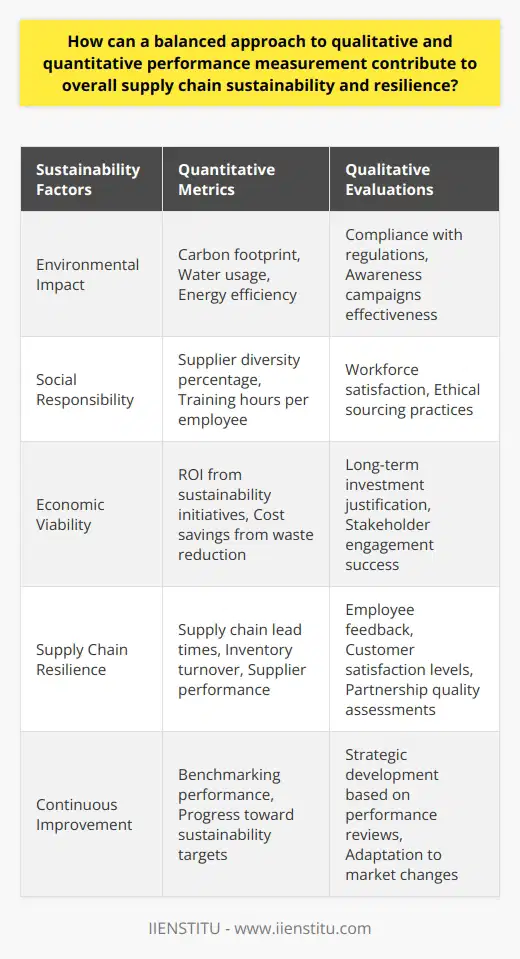
What are the primary distinctions between qualitative measures and quantitative measures in the context of supply chain management?
Qualitative Vs. Quantitative Measures in Supply Chain Management
Understanding the Metrics
In the context of supply chain management, the primary distinctions between qualitative and quantitative measures stem from the nature of the data collected and its subsequent analysis. Quantitative measures in supply chain management involve numerical data and statistical analysis to measure the performance of specific aspects within the system. These measures can include inventory levels, lead times, error rates, and cost performance. In contrast, qualitative measures emphasize a more nuanced understanding of the system and its components, relying on subjective data and descriptive information to evaluate performance.
Significance of Quantitative Measures
Quantitative measures are crucial for assessing the efficiency and effectiveness of supply chain operations. These numerical data points provide valuable insights on the system's overall performance and highlight areas requiring improvement. For instance, tracking on-time delivery rates or inventory turnover ratios can shed light on how well a supply chain reacts to fluctuations in demand. Additionally, the availability of historical data allows businesses to identify trends, set performance benchmarks, and monitor progress towards achieving their goals.
Role of Qualitative Measures
While quantitative measures provide the foundation for supply chain analysis, qualitative measures complement this by adding breadth and depth to the insight. Through gathering non-numerical data such as customer feedback, employee opinions, and supplier relationships, qualitative measures help paint a more comprehensive picture of supply chain performance. These measures capture the less tangible aspects of the system, including communication, collaboration, and cultural alignment. By assessing both quantitative and qualitative measures, businesses can gain a holistic understanding of their supply chain's performance, ultimately making more informed decisions for improvement and optimization.
Balancing Both Approaches
Achieving supply chain excellence requires an appropriate balance between quantitative and qualitative measures. Overreliance on either approach can lead to limited understanding and incomplete assessment. Hence, businesses should actively seek out opportunities to combine both types of measures to continually drive supply chain performance improvements. Integrating both qualitative and quantitative elements ensures that businesses extensively evaluate their supply chain operations, detecting any areas of concern or opportunities for growth.
In conclusion, understanding the primary differences between qualitative and quantitative measures is essential for a robust evaluation of a supply chain's performance. While quantitative measures offer objective data on operational efficiency, qualitative measures provide more context to assess the intangible aspects of supply chain management. By leveraging both types of measures, businesses can guide their decisions and actions to achieve a higher level of supply chain performance.
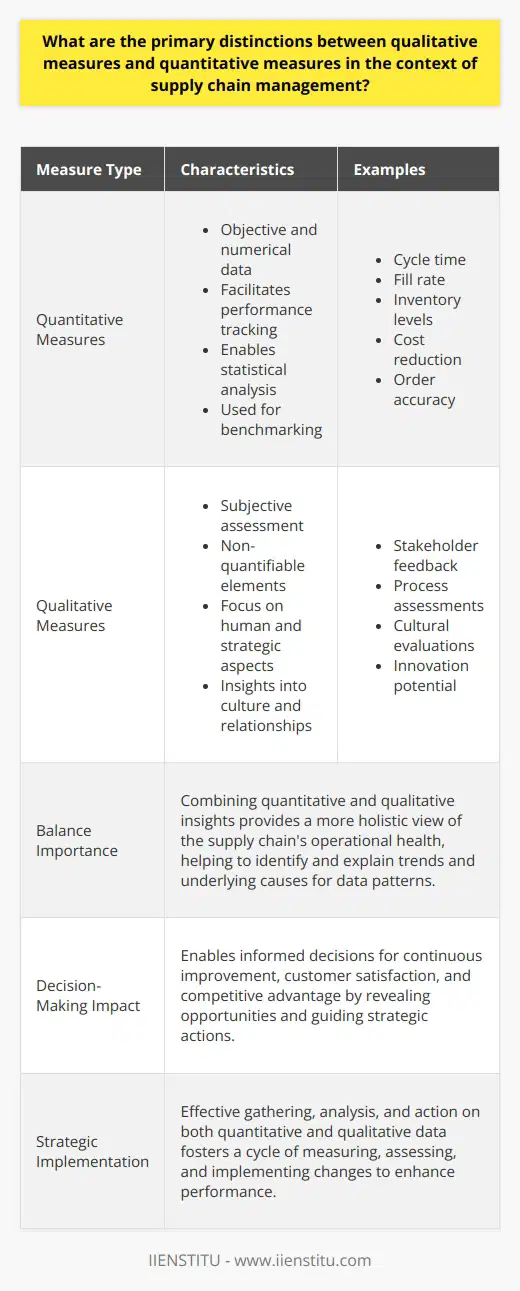
How can organizations effectively integrate qualitative and quantitative metrics to maximize supply chain efficiency and effectiveness?
Integrating Qualitative and Quantitative Metrics
To maximize supply chain efficiency and effectiveness, organizations must effectively integrate qualitative and quantitative metrics. Achieving this integration requires a strategic approach to data collection, analysis, and management.
Establish Clear Objectives
First, organizations should establish clear objectives for their supply chains. These objectives should align with organizational goals and consider factors such as cost, quality, and speed. With objectives in place, an organization can identify appropriate qualitative and quantitative metrics to track performance.
Selecting Appropriate Metrics
Quantitative metrics, such as lead times, inventory levels, and fill rates, provide concrete measurements of supply chain performance. Qualitative metrics, on the other hand, help organizations understand the underlying reasons for performance variations. These can include supplier relationships, process efficiency, and employee engagement. Combining both types of metrics allows for a comprehensive assessment of supply chain effectiveness.
Create a Balanced Scorecard
A balanced scorecard can serve as a valuable tool for integrating these metrics. This approach involves measuring performance across four key areas: financial, customer, internal processes, and learning and growth. By incorporating qualitative and quantitative metrics into the balanced scorecard, organizations can evaluate their supply chain operations from multiple perspectives.
Use Data Visualization Tools
Data visualization tools can be instrumental in communicating complex supply chain insights to decision-makers. By presenting both quantitative and qualitative data in a visually engaging manner, organizations can more easily identify trends, patterns, and areas for improvement. Data visualization can also facilitate cross-functional collaboration by making supply chain information accessible to a wider audience.
Regularly Reassess Metrics
Finally, organizations should regularly reassess their chosen metrics to ensure alignment with evolving organizational goals and industry best practices. Supply chain performance should be consistently monitored, with adjustments made as needed. This ongoing assessment process enables organizations to remain agile and responsive in an ever-changing business environment.
In conclusion, integrating qualitative and quantitative metrics in supply chain management involves a strategic approach to data collection and analysis. By implementing a balanced scorecard, making use of data visualization tools, and regularly reassessing chosen metrics, organizations can optimize their supply chain operations for maximum efficiency and effectiveness.
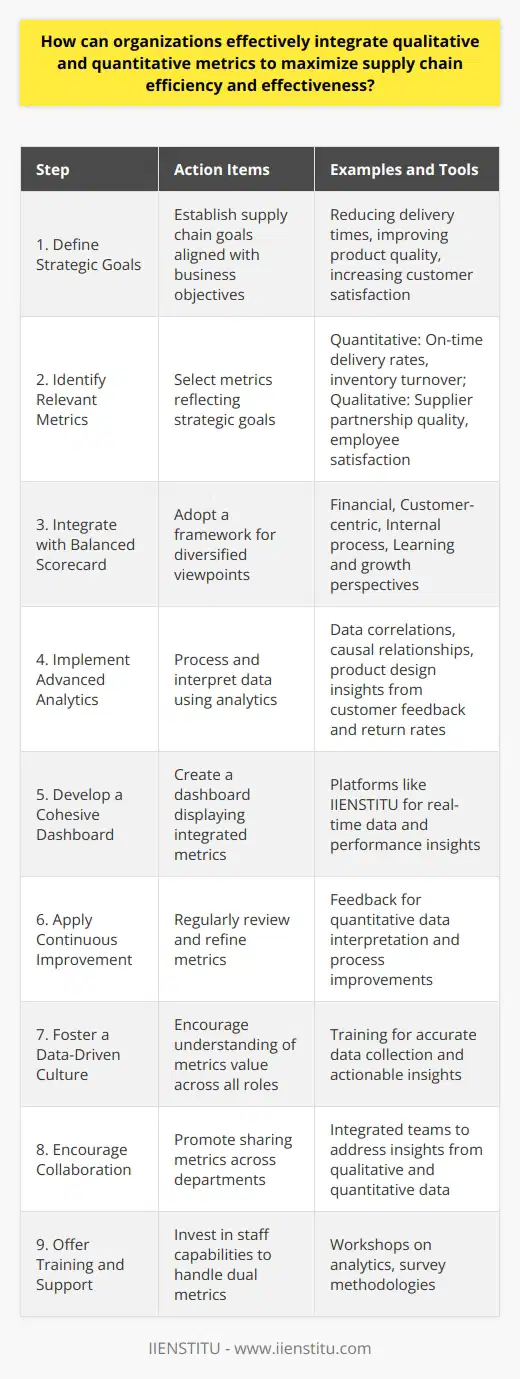
What are some examples of quantitative and qualitative measures commonly used in supply chain management, and how do they contribute to enhancing overall performance?
Quantitative Measures in SCM
Quantitative measures in supply chain management (SCM) are metrics that provide numerical data or values. These measures help organizations track performance, identify efficiency gaps, and compare their performance to industry averages. Common quantitative measures in SCM include order lead-time, inventory levels, delivery time, and order accuracy. These metrics allow companies to evaluate and improve their supply chains' speed, reliability, and responsiveness.
Order Lead-Time
Order lead-time is the time it takes to fulfill a customer's order, from receiving the request to delivering the product. Reducing lead-time enhances customer satisfaction and increases the rate of returning customers. Monitoring lead-time can also reveal areas requiring improvement within the supply chain.
Inventory Levels
Managing inventory levels ensures that products are available when needed and avoids issues like stockouts or excess stock. Employing effective inventory management strategies contributes to cost reduction, product availability, and overall supply chain efficiency.
Delivery Time
Delivery time measures the time it takes for a product to reach a customer once it is shipped. Accurate and timely deliveries enhance customer satisfaction and contribute to a company's reputation. Tracking this metric indicates how well the supply chain's transport and logistics systems are functioning.
Order Accuracy
Order accuracy assesses if products delivered match the customer's order. High accuracy levels demonstrate that products are being picked, packed, and shipped correctly. Maintaining a high level of order accuracy enhances customer satisfaction and reduces the costs and time associated with returns.
Qualitative Measures in SCM
Qualitative measures in SCM provide valuable insights that cannot be expressed in numerical values. These measures include customer satisfaction surveys, employee engagement surveys, and supplier performance evaluations. Analyzing qualitative data can reveal hidden challenges and opportunities to improve a supply chain's overall performance.
Customer Satisfaction Surveys
Monitoring customer satisfaction is crucial for retaining existing customers and attracting new ones. Customer feedback provides insights into the performance of the supply chain, such as product quality, ease of ordering, and delivery efficiency. This information helps companies identify areas that need improvement.
Employee Engagement Surveys
Engaged and motivated employees are vital to a supply chain's efficiency and success. Employee engagement surveys provide insights into workforce satisfaction, motivation levels, and work environment quality. Regularly conducting these surveys can highlight areas for improvement, contributing to increased workforce productivity and retention.
Supplier Performance Evaluations
Evaluating supplier performance helps maintain strong relationships with strategic partners. Criteria for assessment include quality, reliability, and responsiveness. Regularly measuring supplier performance contributes to supply chain efficiency and enhances the overall performance of the organization.
Conclusion
Both quantitative and qualitative measures are essential for understanding a supply chain's overall performance. By monitoring these measures, organizations can make informed decisions to improve efficiency, reduce costs, and enhance customer satisfaction, ultimately contributing to a successful and competitive supply chain.

What are the various approaches and methodologies for integrating qualitative and quantitative measures in supply chain management?
Approaches to Integrating Qualitative and Quantitative Measures
Many strategies exist for complementarily using qualitative and quantitative techniques in supply chain management. Triangulation is a popular approach. This methodology captures a fuller, complex understanding of supply chains by relying on multiple data sources, theories, and methods – both qualitative and quantitative.
Sequential Methodologies
Researchers often use sequential methodologies. This approach involves collecting and analyzing one data type initially while using the other subsequently. For example, a study could begin with a quantitative survey. This helps in understanding the numerical data. Afterwards, researchers pursue a qualitative investigation. This latter phase help to understand the context or mechanics behind the initial numerical findings.
Concurrent Methodologies
Another useful approach is concurrent methodologies. Here, researchers collect and analyze both qualitative and quantitative data simultaneously. They consider both data types as equally important. Thus, they carry out both investigations in tandem.
Complementarity Strategies
Furthermore, complementarity strategies are also effective in integrating the two measures. These strategies involve utilizing qualitative methods to elaborate on, illustrate, or clarify quantitative findings. Or, they may use quantitative methods to validate or confirm qualitative findings. They are effective in illuminating different facets of the supply chain.
Transformative Approaches
Transformative approaches are also useful. They involve collecting and analyzing quantitative data while simultaneously focusing on the social justice aspects of the study using qualitative methods.
In conclusion, each methodology offers unique insights into the intricacies of supply chain management. Successful integration of both types of data can lead to better accuracy, reliability, and understanding of supply chain operations.
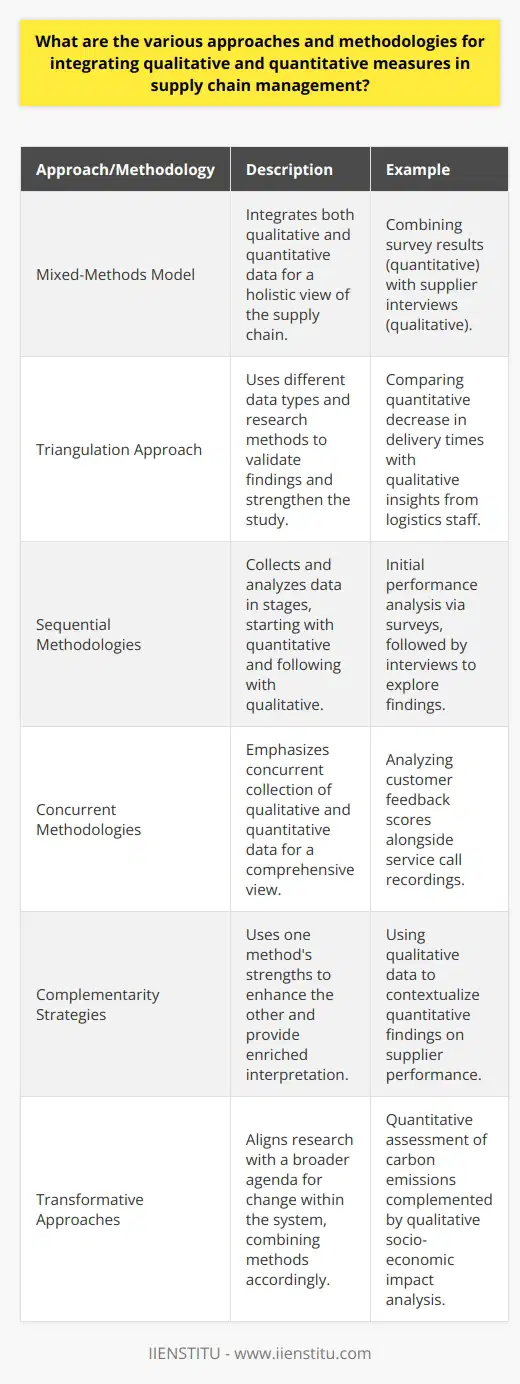
How has the use of qualitative and quantitative performance metrics in supply chain management evolved over time, and what are the implications for contemporary supply chain strategies?
Early Performance Metrics in Supply Chain Management
Initially, supply chain management primarily focused on efficiency and cost reduction. Traditional performance metrics included quantitative measures, such as inventory turnover and on-time delivery rates. These data-centric metrics, while crucial, didn't account for qualitative aspects, like vendor reliability and product quality.
Introduction of Qualitative Metrics
Over time, companies recognized the importance of incorporating qualitative measures. These could capture some intangible aspects of the supply chain, for example, customer satisfaction and supplier relationships. Within this context, qualitative metrics became equally important in understanding the total performance of the supply chain.
Impact on Contemporary Supply Chain Strategies
Contemporary supply chain strategies now heavily rely on a balanced mix of both qualitative and quantitative metrics. The incorporation of these two different types of metrics has created a more holistic view of supply chain operations. It allows managers to make more nuanced decisions that take into account a wide range of operational, financial, and relational factors.
Implications for Future Trends
In sum, the evolution of performance metrics in supply chain management demonstrates a move towards more comprehensive and balanced measurement methods. This development suggests an increasing expectation for supply chain strategies to be adaptive, responsive, and nuanced in addressing both quantitative and qualitative aspects of the business. Hence, future trends in supply chain management will likely continue to explore metrics that capture a more complete picture of corporate performance.
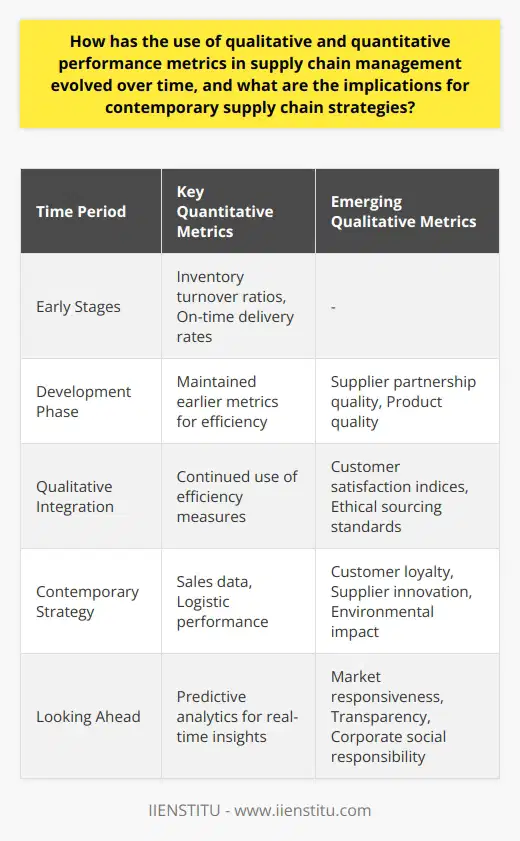
What is the role of technology and data analytics in enhancing the effectiveness of qualitative and quantitative measures in supply chain management?
Role of Technology in SCM
The role of technology in enhancing the effectiveness of supply chain management (SCM) is substantial. It brings about precision, efficiency, and automation. E.g. automated inventory systems reduce errors and improve accuracy.
Integrating Systems and Processes
Software systems streamline supply chain processes. They enable seamless integration of various supply chain activities such as procurement, production, and distribution.
Influence of Data Analytics
Data analytics is a key tool in improving quantitative and qualitative measures in SCM. It aids in crunching vast amounts of data to obtain actionable insights, thus increasing operational efficiency.
Predictive Analytics in Demand Forecasting
An application of data analytics, known as predictive analytics, helps in demand forecasting. Accurately predicting demand can eliminate stock-out situations or excess inventory.
Real-Time Tracking and Monitoring
Moreover, technology aids in real-time tracking and monitoring of goods in the supply chain. This provides visibility, enabling timely decisions, and proactive problem solving.
Data-Driven Decision Making
Data analytics also enables data-driven decision making, which enhances strategic planning. It allows managers to identify trends, track performance metrics, and make informed decisions.
In conclusion, the application of technology and data analytics significantly enhances the effectiveness of both qualitative and quantitative measures in SCM. It revolutionizes processes, improves efficiency, and adds value to the overall operation. The systematic analysis of supply chain data and the use of advanced algorithms allows better prediction, planning and execution of supply chain activities, thereby enhancing competitiveness and profitability.
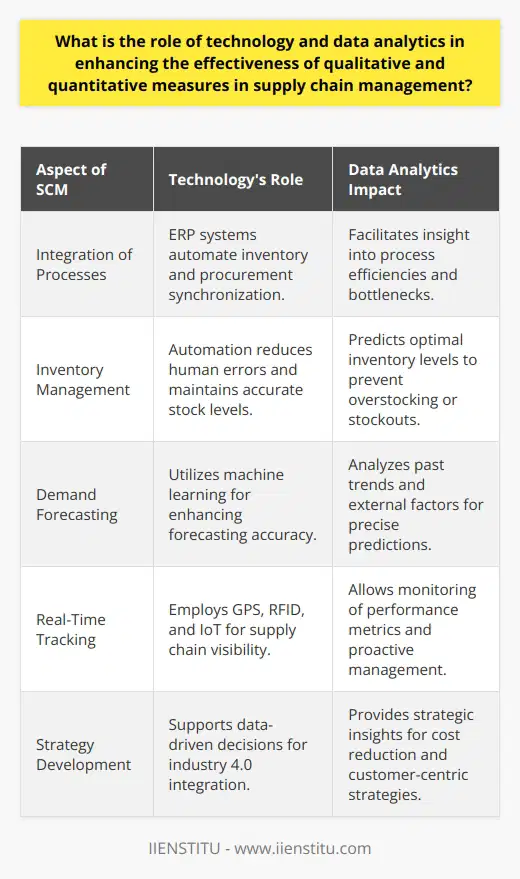
What are the key factors influencing the choice and application of qualitative and quantitative measures in supply chain management?
Understanding Decision Factors
Key factors influence the choice and use of qualitative and quantitative measures in supply chain management. These factors predominantly include strategy alignment, cost-benefit analysis, and process complexity.
Aligning with Strategic Objectives
The first critical factor is strategy alignment. Supply chain measures should align with the strategic objectives of the organization. For instance, if a company's strategy emphasizes customer satisfaction, then qualitative measures such as customer feedback can be necessary.
Weighing Cost and Benefits
A second key factor is cost-benefit analysis. Managers need to weigh the cost of collecting and analyzing data against the benefits it provides. For example, using complex quantitative measures may not be justifiable if the insights gained do not translate into significant operational improvements or cost savings.
Assessing Process Complexity
Lastly, the complexity of the supply chain process can influence the choice of measures. Quantitative measures usually work well for simple processes, while qualitative measures might be more effective for complex operations where human judgment and expertise are important.
In conclusion, selecting the appropriate measures in supply chain management depends on multiple factors, including strategy alignment, cost-benefit analysis, and the complexity of the process. Understanding these factors can guide managers to choose the most appropriate and effective measures for their operations.
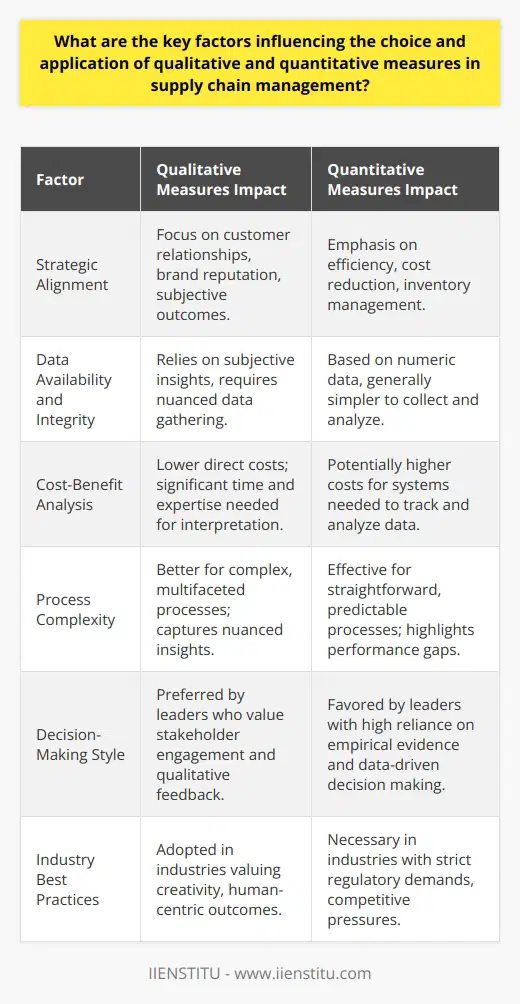
How do organizations align qualitative and quantitative performance metrics with supply chain management objectives and strategies?
Defining Metrics
Organizations commence by defining relevant metrics that reflect supply chain management (SCM) objectives and strategies. Metrics often align with the broader organizational goals, whether financial, operational, or customer-centric. They encompass both the qualitative and quantitative aspects of performance measurement.
Qualitative Metrics
Qualitative metrics offer insights into non-numerical factors affecting the supply chain. They may include supplier relationships, process efficiencies, and customer satisfaction. It's pivotal to align these measures with the SCM objectives to track progress and foster improvement effectively.
Quantitative Metrics
Quantitative metrics provide measurable data that evaluate the performance of a supply chain. These can range from delivery times and order accuracy to inventory turnover and cost per unit. Aligning these metrics with SCM strategies allows companies to assess whether their strategic actions lead to quantifiable improvements. This alignment helps with decision making, planning, and evaluation.
Integration of Metrics
Organizations integrate qualitative and quantitative metrics to develop a comprehensive performance evaluation framework. Such integration helps in identifying areas for improvement and implementing corrective measures. It allows organizations to monitor and adjust their supply chain activities in a balanced manner.
Performance Reporting
Lastly, organizations employ performance reporting to communicate the results of these metrics. Consistent reporting enables the alignment of SCM objectives with the overall business goals. It also promotes accountability, transparency, and continuous improvement in the supply chain operations.
In summary, the effective alignment of qualitative and quantitative performance metrics with SCM objectives and strategies contributes significantly to the supply chain's robustness and competitiveness. It provides a clear path to achieving business goals and allows organizations to thrive in today’s fast-paced and complex business environment.
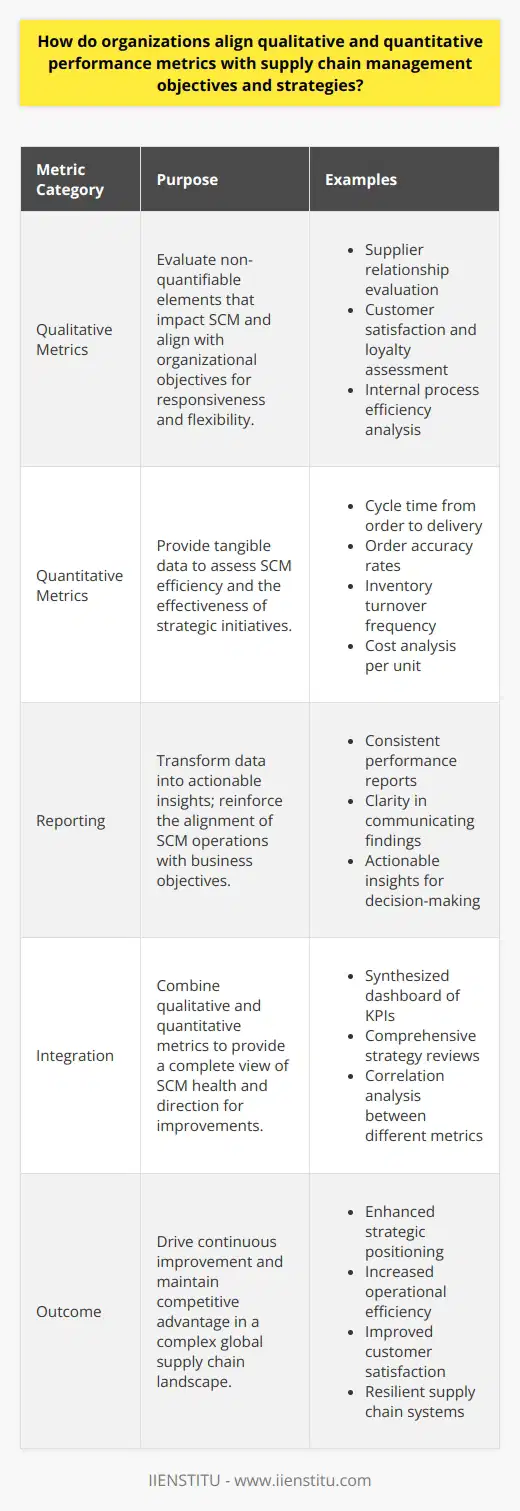
What is the practical significance and theoretical underpinning of utilizing both qualitative and quantitative performance metrics when evaluating supply chain management processes?
Utilizing Both Metrics: Importance and Underpinnings
The application of both qualitative and quantitative performance metrics offers practical importance in evaluating supply chain management processes. Through this dual approach, managers can precisely measure efficiency and effectiveness. This includes numerical assessment of deliveries, transit times, or costs (quantitative metrics). Moreover, it gauges the satisfaction of customers or improvement in relationships with suppliers (qualitative metrics).
Theoretical Frameworks and Pragmatic Impact
Theoretically, this combination of metrics helps deliver a well-rounded understanding. It applies multiple research paradigms such as positivism (often associated with quantitative methods) and interpretivism (often related to qualitative methods). By drawing on both, an organization ensures a comprehensive grasp of its supply chain. The flexibility provided by the combined approach can adapt to varied situations, enhancing decision-making capabilities.
Gauging Supply Chain Performance: A Balanced Perception
Quantitative metrics provide solid data allowing for comparability, trends, and patterns, facilitating a factual understanding of chain operations. However, the inclusion of qualitative metrics lets organizations comprehend the nuanced and subjective aspects. Thus, implementing a mix of both metrics allows a more profound, detailed, and balanced assessment of supply chain management processes.
In conclusion, while quantitative metrics offer measurable, precise values on performance, qualitative metrics add richness and depth to the evaluation. Therefore, the application of both metrics, grounded in diverse theoretical underpinnings, helps enrich supply chain evaluation processes, promoting effective decision-making. This approach ultimately aids in maximizing efficiency and effectiveness in supply chain management.

What are the most effective ways to combine qualitative and quantitative measures for a holistic approach to supply chain management?
Integration of Quantitative and Qualitative Measures
Applying a combined approach to supply chain management can significantly enhance the effectiveness of this vital business operation.
Combining Measures for Analysis
Firstly, market researchers can use both qualitative and quantitative methods to gather and analyze supply chain data. This confluence optimizes the collection of comprehensive information, thereby providing a broader understanding of supply chain processes.
Role of Quantitative Measures
Quantitative measures form the backbone of this integrated approach. They offer crucial data such as delivery times, costs, and supplier performance metrics. These factors can help establish a better understanding of the supply chain's logistical aspects.
Influence of Qualitative Measures
On the other hand, using qualitative measures allows for in-depth explorations of complex supply chain dynamics. Methods such as interviews, focus groups, and observations can inform insights into employee satisfaction, supplier relationships, and customer behavior. This can present a nuanced, well-rounded picture of how the supply chain operates.
Balancing Quantitative and Qualitative Approaches
To effectively incorporate both kinds of measures, balance becomes essential. Having an overemphasis on one approach can create an incomplete image of the supply chain. Mixing quantitative and qualitative methods ensures objective analysis and human-centered understanding concomitantly.
Conclusion
In conclusion, integrating qualitative and quantitative measures can offer a comprehensive, effective approach to supply chain management. Adopting this strategy can bolster operational efficiency by providing a balanced, holistic perspective of this crucial business function.
In an ever-evolving business landscape, such strategies ensure fluid, versatile supply chains ready to adapt to any changes.
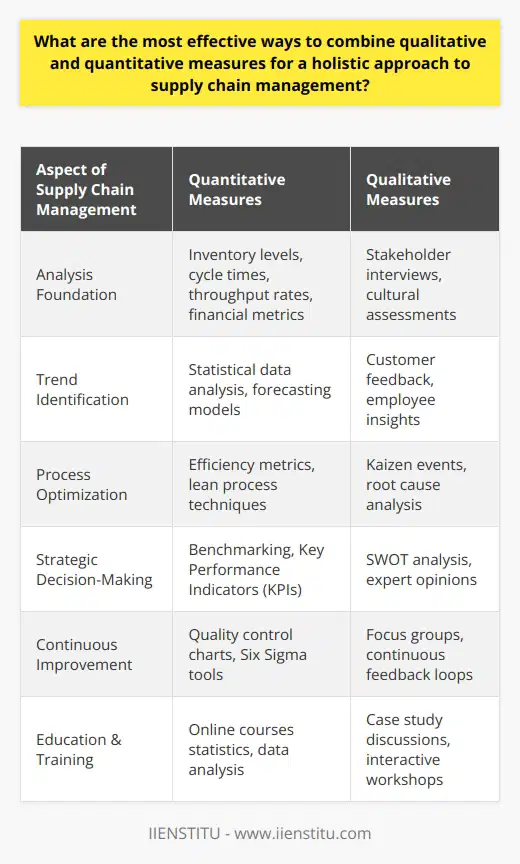
How do cultural and organizational factors influence the implementation of qualitative and quantitative metrics in supply chain management?
Cultural Influence on Metric Implementation
The influence of cultural factors on the application of qualitative and quantitative metrics in supply chain management is profound. Cultural variations shape the attitude, perception, and interpretation of information, thereby affecting the execution of these metrics. Employees from diverse cultures may perceive and interpret data differently, influencing the decision-making process.
Organizational Impact on Metric Implementation
Likewise, organizational factors also play a vital role in the utilization of qualitative and quantitative metrics. Organizational structure, policies, leadership style, and operational processes interact to shape the method of metric implementation. For instance, an organization with a flat structure might foster open communication and feedback, enabling better adoption of these metrics.
Interaction between Cultural and Organizational Factors
Cultural and organizational factors interact to create a unique environment that impacts the assimilation of these metrics. A positive organizational culture that embraces diversity can potentially offset the challenges posed by cultural differences. It compels the organization to develop a system that manages these cultural variations appropriately for effective metric implementation.
Influence of Technology and Training
Further, the role of technology and training in dealing with cultural and organizational factors cannot be understated. A technologically advanced system can aid in mitigating the effects of cultural differences. Additionally, proper training and education can help the workforce to understand and implement the metrics effectively despite their cultural backgrounds.
In conclusion, cultural and organizational factors significantly impact the application of qualitative and quantitative metrics in supply chain management. Recognizing and managing these factors effectively can greatly enhance metric implementation and overall supply chain performance.

In the context of supply chain management, how can the integration of qualitative and quantitative measures lead to continuous improvement and innovation?
Integration of Measures
The integration of qualitative and quantitative measures plays a critical role in supply chain management. Quantitative measures offer numerical insights into supply chain efficiency, providing data on crucial aspects like inventory levels, delivery times, and order accuracy. Meanwhile, qualitative measures hold immense value in providing subjective insights and value judgments about the supply chain process.
Continuous Improvement
Utilizing both approaches together gives businesses a more holistic viewpoint of their supply chain performance. Quantitative data can identify possible issues or inefficiencies, upon which, qualitative measures can further explore. For instance, if the quantitative data indicates a decline in delivery times, qualitative insights can help understand the reasons, such as supplier challenges or transporter inefficiencies. This dualistic approach aids in continuously improving and refining the supply chain practices based on consistent feedback and data.
Innovation Initiation
Similarly, the integration of both approaches can stimulate innovation in supply chain management. Quantitative measures expose the areas where an organization needs improvement. Subsequently, qualitative insights can provide creative and innovative solutions. For instance, qualitative measures might point out the need for a more effective communication system among employees to improve delivery times – a problem disclosed by the quantitative data. Thus, integration can stimulate innovation by identifying areas of improvement and suggesting novel solutions.
In conclusion, quantitative and qualitative measures are complementary to each other. Only when integrated, they can offer a comprehensive view of the supply chain and lead to continuous improvement and innovation.
